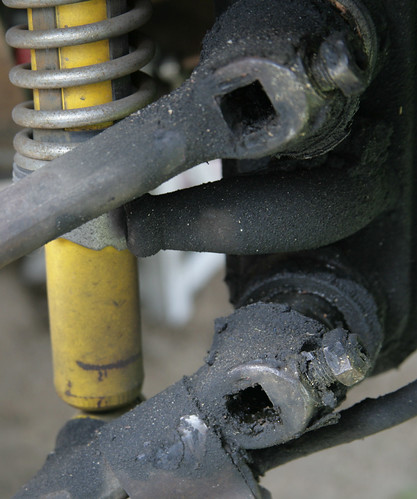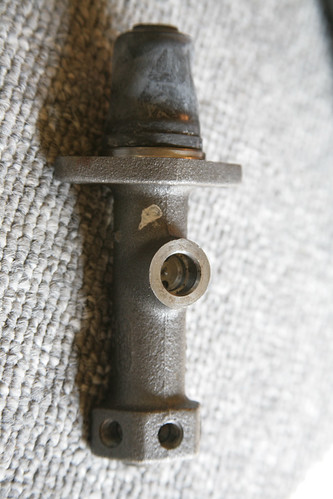
After doing all the previous work on our '65 Beetle, I decided that I ought to drive it for a few days just to be sure everything was okay, before turning it back over to Carol. I really didn't want her to have to experience another disaster. It was a very good thing that I made that decision.
One afternoon, I hopped in the car, started the engine and headed off to work. I was half way there, about five miles from home, and all of a sudden, when I pushed in the clutch pedal so I could shift gears, the pedal went right to the floor and there it stayed. Of course I was on the freeway, three lanes over from the right and in the middle of lots and lots of afternoon traffic. I maneuvered my way over to the right lane and took the next exit off of the freeway. As I coasted to a stop and eased the transmission out of gear, I breathed a sigh of relief that at least I was off the freeway and out of the traffic stream.
I knew that, in theory, I should be able to shut off the engine, slip the car into gear and then crank the starter. If the engine is tuned properly, again in theory, I ought to be able to start the car in gear and get it going down the street. Once the engine was running and the car was moving, it should be possible to ease the transmission into a higher gear without using the clutch. In this way, I might just be able to cripple the car home, get it parked and use another of my cars to get to work. At the next stop, I pulled over to the side of the street and called in to work to let them know that I was having car trouble and would be a little late. After a bit of experimentation, I developed a technique of coming to a stop, shutting off the engine, shifting into first gear, starting the engine, getting the car moving, easing the shifter into third gear, driving to the next stop and repeating the process. I made it home, transferred my gear to another of my VWs and got to work only about a half hour late. I was glad that the clutch failure hadn't happened to Carol.
The most common part to fail in the VW clutch system is the cable which extends from the pedal cross-shaft back to the transaxle at the rear of the car. The next day I picked up new cable from the parts store. The shop where I buy my parts is one with which I been doing business for over 20 years, so a "parts run" is quite often as much a social event as a shopping trip. This run was no exception and, after swapping a few stories, including my adventure of the day before, I paid for my parts and headed home.
The next day, I backed up the car onto a couple of ramps and began taking it apart so that I could replace the broken cable. Oddly, when I removed the pedal set from under the dash, it turned out that the cable was sound and that it was the pedal cross-shaft that had failed. You see, when you push the clutch pedal down, the shaft to which it is attached rotates and causes the hook on the other end of that shaft to pull the cable forward which in turn disengages the clutch and allows you to change gears. In the 30 plus years during which I've owned and maintained air-cooled Volkswagens, this was only the second time I'd seen this type of failure. I had the wrong part for the repair, of course, so it would take another parts run and another day or two to get the car fixed and back on the road.
Here is a bit of advice for you from someone who has learned nearly everything the hard way: If you can, take the old part with you when you go to the parts store. That way you'll nearly always end up bringing the correct part home with you. You'll notice that I said "nearly always." Sometimes the part that you took off the car and brought with you was the wrong part and was installed in error by the last person who worked on your car, so the other bit of advice I would offer you is to know as much as possible about the parts that are attached to your car. With old air-cooled Volkswagens of any year, many parts are interchangeable. That being the case, many of the parts on the car you are dealing with may already have been interchanged. Taking photos and measurements can help you identify parts that seem to be different than what was originally intended to be attached to your car. This mixing and matching of parts is not a bad thing, but when the substitution is not documented, it may take you awhile to figure out what year vehicle any given part was originally intended to be attached to. This will matter when it comes to replacing brake shoes and brake system parts, ignition parts, fuel system parts, and cables to name a few. Once you figure it all out, you might want to create a written record of some sort in which to document your findings so that you can pass them along to the next person who owns the car. They'll thank you for it, believe me.
Now that I had fixed all the major systems on this car, it was time to start working on the luxury items like the heater and the glove box door.





